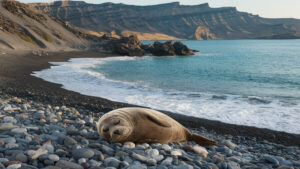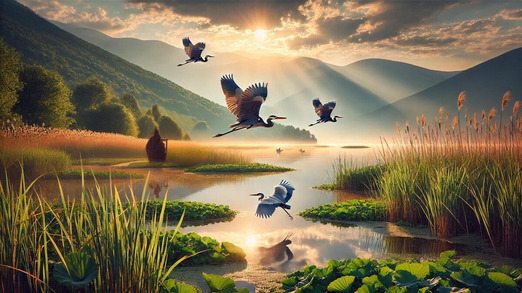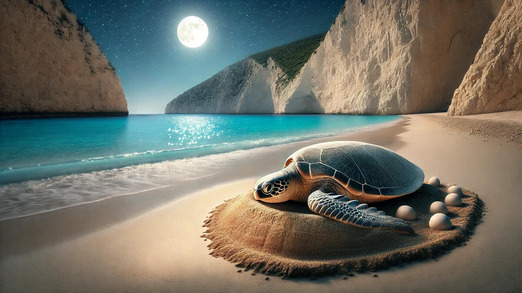
Are there animals in Greece worth seeing? When you think of Greece, ancient ruins and sun-soaked beaches probably come to mind—but there’s so much more waiting to be discovered. Imagine spotting playful dolphins leaping alongside your boat or catching a glimpse of a rare Mediterranean monk seal basking on a quiet shoreline. Whether you’re hiking through mountain trails or sailing along the coast, you’ll encounter animals that make Greece’s natural beauty even more unforgettable.
Bears in Greece? Uncover the Wild Side of Adventure
 What if your next adventure included a chance to spot a brown bear in the heart of Greece? While millions flock to this Mediterranean paradise for its ancient ruins and pristine beaches, there’s a wild side to Greece that most travelers never discover.
What if your next adventure included a chance to spot a brown bear in the heart of Greece? While millions flock to this Mediterranean paradise for its ancient ruins and pristine beaches, there’s a wild side to Greece that most travelers never discover.
Many visitors simply don’t realize that there are so many animals native to Greece. They plan their trips around historical sites and beach-hopping, missing out on extraordinary opportunities to witness bears, dolphins, rare birds, and other Greek animals in their natural habitats.
But here’s the exciting part: you don’t have to choose between classic Greek experiences and wildlife adventures. This guide will show you how to weave unforgettable wildlife encounters into your Greek journey through hiking, sailing, and exploration.
Why Greece Is a Hidden Gem for Wildlife Enthusiasts
A Land of Contrasts: Mountains, Seas, and Biodiversity
When you picture Greece, your mind likely wanders to sun-bleached ruins, whitewashed villages, and crystal-clear Mediterranean waters. But beyond these iconic scenes lies a wild secret that few travelers discover – Greece hosts an incredibly diverse array of wildlife that would surprise even the most seasoned adventurer. As someone who’s tracked brown bears through the Pindos Mountains and kayaked alongside curious dolphins in the Ionian Sea, I can tell you that Greece wildlife offers some of Europe’s most extraordinary encounter opportunities.
From the jagged peaks and thick forests blanketing the mainland to the thousands of islands dotting the azure seas, Greece’s landscape is incredibly diverse. These distinct environments – each with their own character – have become safe havens for some of Europe’s most fascinating creatures. While brown bears roam the remote mountain valleys, elusive monk seals find refuge along secluded island shores.
Misconceptions About Greek Wildlife
 Many travelers don’t realize that Greece is one of the few European countries where you can still find large predators roaming freely. The remote Pindos Mountains harbor a healthy population of brown bears, while wolves still patrol the forests of Macedonia and Thrace. In fact, according to research by the environmental organization Callisto, Greece’s brown bear population has shown remarkable recovery in recent years, making it one of Europe’s most important strongholds for these magnificent creatures.
Many travelers don’t realize that Greece is one of the few European countries where you can still find large predators roaming freely. The remote Pindos Mountains harbor a healthy population of brown bears, while wolves still patrol the forests of Macedonia and Thrace. In fact, according to research by the environmental organization Callisto, Greece’s brown bear population has shown remarkable recovery in recent years, making it one of Europe’s most important strongholds for these magnificent creatures.
It’s not just about the large mammals. Greece serves as a crucial stopover point along major bird migration routes between Europe and Africa. The country’s wetlands transform into vibrant gathering spots for thousands of flamingos, pelicans, and other water birds during migration seasons. Meanwhile, the Mediterranean waters teem with life – from playful dolphins and loggerhead turtles to the critically endangered Mediterranean monk seal.
What makes wildlife watching in Greece particularly special is how seamlessly it integrates with other outdoor adventures. You might spot a golden eagle while hiking ancient mountain trails, encounter a family of wild boars during a forest trek, or find yourself sailing alongside a pod of striped dolphins. This natural wealth, combined with Greece’s rich cultural heritage, creates a unique opportunity for travelers to experience both wildlife and history in one remarkable destination.
Ready for Your Next Adventure?
I want my FREE Adventure Travel Guide & Packing / Budget Planner!
The Majestic Mammals of Greece
Meet the Elusive Brown Bear
 Deep in the Pindos Mountains, where ancient forests meet misty peaks, lives one of Greece’s most magnificent creatures – the brown bear. Yes, Greece is indeed home to these impressive mammals, with around 450-550 bears roaming the country’s northern regions. Most fascinating is their miraculous recovery story; from near extinction in the 1960s to a thriving population today, these bears represent one of Europe’s most successful conservation efforts.
Deep in the Pindos Mountains, where ancient forests meet misty peaks, lives one of Greece’s most magnificent creatures – the brown bear. Yes, Greece is indeed home to these impressive mammals, with around 450-550 bears roaming the country’s northern regions. Most fascinating is their miraculous recovery story; from near extinction in the 1960s to a thriving population today, these bears represent one of Europe’s most successful conservation efforts.
The bears here have adapted uniquely to the Mediterranean environment, being slightly smaller than their northern European cousins but no less majestic. They favor the dense forests and alpine meadows of regions like Grevena and Florina, where they forage for a diverse diet of berries, herbs, and occasionally honey from wild bees (a treat that would make Winnie the Pooh jealous!).
Wolves and Wild Boars: Forest Guardians
While bears might steal the spotlight, Greece’s forests harbor other impressive predators. The Greek wolf is a distinct subspecies of the grey wolf. It still roams in packs through the northern mountains. These intelligent, but elusive, creatures play a crucial role in maintaining the ecosystem’s balance, though catching a glimpse of one requires exceptional luck and patience. Recent estimates suggest about 800-1000 wolves call Greece home, primarily in the rugged terrain of Macedonia and Thrace. Wolves can be found in the Dadia-Lefkimi-Soufli Forest National Park near the border with Türkiye.
Wild boars have made a remarkable comeback across the Greek mainland. These sturdy survivors can be found from the depths of mountain forests to the edges of rural villages. They’re particularly active at dawn and dusk, when you might spot them foraging with their striped piglets in tow. Despite their intimidating appearance, they generally avoid human contact, though it’s wise to keep a respectful distance.
Pro Tip: Maximize your chances of spotting these magnificent creatures by joining a guided wildlife tour with [trusted local operator]. Many tours offer a perfect blend of nature and culture by combining wildlife watching with traditional village visits.
The Kamaki: A Uniquely Wildlife Wonder Among the Animals of Greece
 While the Mediterranean sun casts its warm glow on the tourist islands of Greece, an equally fascinating creature emerges—one that’s often overlooked in traditional nature guides: the Kamaki. This charming species, known scientifically as graecus seductor, is an elusive but highly effective predator in the wild summer nights of Greece.
While the Mediterranean sun casts its warm glow on the tourist islands of Greece, an equally fascinating creature emerges—one that’s often overlooked in traditional nature guides: the Kamaki. This charming species, known scientifically as graecus seductor, is an elusive but highly effective predator in the wild summer nights of Greece.
As I sat with friends at a taverna by the waterfront, we couldn’t help but observe this unique specimen in its natural habitat. Giorgos (George in English), a prime example of the kamaki (spear fisher) species, would walk by with a beautiful woman on his arm. The woman obviously visiting the island from lands far away, her eyes wide with wonder at the sights of the island. Giorgos, on the other hand, walked with the confidence of a man who had seen it all.
They’d enjoy the island’s offerings for a few days, perhaps even a week, and then—poof—she’d be gone. Her plane left at 10 a.m. and by 2 p.m. Giorgos had already replaced her with another equally entrancing female. The script was repeated over and over again.
Some might say that Giorgos was the apex predator of the island’s bustling tourist scene, but I can’t say. What I can say with certainty is that the kamaki’s charm seems to work—on the women, on the men, and perhaps even on the very ecosystem of the island itself. It’s a delicate balance, really, a fascinating dance between prey and predator, with everyone involved seemingly satisfied by the arrangement. And thus, Giorgos, one of the many kamaki of Greece, becomes yet another of the island’s fascinating “wildlife” wonders often seen each summer throughout the tourist islands of Greece.
Birdwatcher’s Paradise: Feathered Friends Among the Best Animals in Greece to See
Endemic Birds of Greece: The Dalmatian Pelican and Beyond
 Among the reeds of Lake Kerkini, a sight unfolds that would make any wildlife enthusiast’s heart skip a beat – Dalmatian pelicans, with their distinctive crimson pouches and silver-white plumage, glide across the water’s surface. These magnificent birds are among the largest flying birds in the world.
Among the reeds of Lake Kerkini, a sight unfolds that would make any wildlife enthusiast’s heart skip a beat – Dalmatian pelicans, with their distinctive crimson pouches and silver-white plumage, glide across the water’s surface. These magnificent birds are among the largest flying birds in the world.
They represent just one of Greece’s avian treasures. The country serves as a critical sanctuary for these endangered creatures, hosting the largest European population outside of Russia.
But pelicans aren’t the only stars of Greece’s bird world. The regal golden eagle soars above the Meteora cliffs, while the elusive rock partridge scuttles through the mountainous terrain of Crete. Perhaps most striking is the Egyptian vulture, known locally as “asproparis” (white priest) due to its distinctive white plumage, though sadly, its numbers have declined dramatically in recent decades.
Migration Hotspots for Bird Lovers
Greece’s position between Europe and Africa is a natural stopover on major migration routes. The wetlands of Prespa Lakes transform into a spectacular natural amphitheater during migration seasons, hosting over 260 bird species throughout the year. Imagine watching thousands of flamingos painting the sky pink as they arrive at Messolonghi Lagoon or observing rare glossy ibis feeding in the shallow waters of the Evros Delta.
The islands play their part, too. Lesvos has earned its reputation as Europe’s spring (March thru May) migration capital, where birdwatchers gather annually to witness the passage of countless species. Time your visit right, and you might see the threatened lesser kestrel hunting over Limnos’s grasslands or hear the distinctive call of Eleonora’s falcon echoing off Tilos’s cliffs.
Exploring the Ocean for the Marine Animals in Greece
Sailing with Dolphins and Sea Turtles

 Picture yourself on a sun-drenched deck, watching bottlenose dolphins playfully surf your boat’s wake in the sparkling Aegean. This isn’t just a dream – it’s a common occurrence in Greek waters, where four different species of dolphins make their home. The striped, bottlenose, common, and Risso’s dolphin all grace these waters, turning an ordinary sailing trip into an unforgettable wildlife encounter.
Picture yourself on a sun-drenched deck, watching bottlenose dolphins playfully surf your boat’s wake in the sparkling Aegean. This isn’t just a dream – it’s a common occurrence in Greek waters, where four different species of dolphins make their home. The striped, bottlenose, common, and Risso’s dolphin all grace these waters, turning an ordinary sailing trip into an unforgettable wildlife encounter.
Even more magical are the gentle loggerhead sea turtles (Caretta caretta) that have been swimming these waters since ancient times. Zakynthos’s Laganas Bay hosts the Mediterranean’s largest nesting population, where these prehistoric-looking creatures lumber onto beaches at night to lay their eggs. Time your visit between May and October, and you might witness either nesting mothers or tiny hatchlings making their moonlit dash to the sea.
Mediterranean Monk Seals: A Rare Sight
 The Mediterranean monk seal, one of the world’s rarest marine mammals, finds sanctuary along Greece’s remote coastlines. With only about 600-700 Mediterranean monk seals left, spotting one of these curious creatures is like winning the wildlife lottery. The best chances come in the Northern Sporades, particularly around Alonissos Marine Park, where conservation efforts have helped maintain a stable population.
The Mediterranean monk seal, one of the world’s rarest marine mammals, finds sanctuary along Greece’s remote coastlines. With only about 600-700 Mediterranean monk seals left, spotting one of these curious creatures is like winning the wildlife lottery. The best chances come in the Northern Sporades, particularly around Alonissos Marine Park, where conservation efforts have helped maintain a stable population.
These charismatic seals often peek at snorkelers and divers from a safe distance, their dog-like faces earning them the local nickname “sea dogs.” While sightings are never guaranteed, islands like Milos and Kimolos offer promising opportunities, especially if you explore their volcanic coastlines by kayak – the quiet approach increases your chances of an encounter without disturbing these endangered Greek animals.
Conservation Note: Remember that these Greek animals are protected species. Always maintain safe distances and follow local guidelines for responsible wildlife viewing. Consider supporting local conservation efforts by joining a [guided eco-tour] that contributes to research and protection programs.
Of Course, There’s More…
Greece’s wildlife scene goes far beyond what most visitors expect. While exploring this ancient land, I’ve encountered some truly remarkable animals that often go unnoticed in typical tourist guides. Take the Kri-Kri goats of Crete – these remarkable creatures seem to defy gravity, navigating near-vertical cliff faces with almost supernatural grace. Their curved horns catch the Mediterranean sunlight as they leap from ledge to ledge, making even the most seasoned mountaineers look amateur.
A favorite surprise was discovering Athens’ unofficial avian residents: wild parrots that have claimed the city as their own. These vibrant birds, descendants of escaped pets, now add splashes of tropical color to the ancient capital. There’s something wonderfully ironic about watching these exotic creatures perch on classical ruins, as if they’ve always belonged there.
The cats of Greece deserve their own chapter in any travel story. These charismatic felines have mastered the art of Mediterranean living, whether they’re sprawled across warm marble steps or holding court in seaside tavernas. They’ve become such an integral part of Greek life that it’s hard to imagine any village or island without them. Each one seems to carry themselves with the dignity of an ancient philosopher, yet they’re not above accepting a gentle scratch behind the ears from admiring visitors.
Speaking of local characters, the donkeys of Greece – particularly on Santorini – tell a story of tradition meeting modern times. These steadfast animals still navigate the countless stone steps connecting clifftop villages, though nowadays, they’re more likely to carry tourists’ cameras than essential supplies. Their clip-clopping hooves on cobblestone paths echo centuries of island life, even as their role evolves with the times.
Every corner of Greece, from its mountain peaks to its island shores, holds the promise of an unexpected wildlife encounter. It’s these spontaneous moments – a Kri-Kri silhouetted against the setting sun, or a parrot swooping past the Parthenon – that transform a simple vacation into an unforgettable adventure.
Don’t Miss Your Free Travel Guide & Planner!
Create an affordable travel adventure! Find how in eBook “Adventure Travel for Every Budget” and use Packing List / Budget Spreadsheet to organize.
Practical Tips for Wildlife Spotting in Greece
Best Time of Year for Wildlife Adventures
Timing is everything when it comes to wildlife spotting in Greece, and each season offers its own unique opportunities. Spring (April-May) brings an explosion of activity as bears emerge from hibernation and migratory birds flood the wetlands. Summer (June-August) is perfect for marine encounters – dolphins are more active, and sea turtles come ashore to nest. Fall (September-October) offers prime bear watching as they bulk up for winter, while winter brings rare birds to the wetlands.
The secret to successful wildlife spotting often lies in the early hours. Most land animals in Greece are most active at dawn and dusk, so plan your hikes accordingly. Marine life tends to be more visible when seas are calm, typically in early morning hours before the afternoon winds pick up. If you’re serious about photography, these golden hours also offer the best natural lighting.
Packing Essentials for Nature Enthusiasts
 Your wildlife adventure is only as good as your preparation. Start with [premium compact binoculars] – they’re worth every penny for spotting distant wildlife while keeping your pack light. A good spotting scope can be game-changing for serious bird watching, especially around wetlands.
Your wildlife adventure is only as good as your preparation. Start with [premium compact binoculars] – they’re worth every penny for spotting distant wildlife while keeping your pack light. A good spotting scope can be game-changing for serious bird watching, especially around wetlands.
Here’s your essential packing list:
-
- Comfortable hiking boots with ankle support for rocky terrain
- Lightweight, layerable clothing in muted colors (avoid bright white)
- A quality rain shell (mountain weather can change quickly)
- High-SPF sunscreen and a wide-brimmed hat
- Plenty of water and trail snacks
- A detailed topographic map or reliable GPS device
- A basic first-aid kit
The most vital piece of equipment? Patience. Wildlife viewing requires quiet observation and sometimes hours of waiting. [This lightweight portable camping chair] can make those waiting periods much more comfortable, especially during dawn wildlife watches.
Pro Tip: Register with local wildlife organizations or hire certified guides to find the best spots. Plus, they often have access to areas that are otherwise restricted to protect sensitive species.
Top Destinations for Wildlife Adventures in Greece
NOTE: For the map’s legend, click on the box in the upper right corner of the image.
Pindos National Park: Land of the Brown Bear and Other Creatures
 Welcome to Greece’s wild heart – Pindos National Park, where ancient forests cloak rugged mountains and brown bears still reign supreme. This vast wilderness in northern Greece is more than just bear territory; it’s one of Europe’s most pristine mountain ecosystems. The park’s mixed forests of black pine and beech create perfect corridors for wildlife movement. At the same time, alpine meadows burst with wildflowers in spring, attracting diverse wildlife from wolves to wildcats.
Welcome to Greece’s wild heart – Pindos National Park, where ancient forests cloak rugged mountains and brown bears still reign supreme. This vast wilderness in northern Greece is more than just bear territory; it’s one of Europe’s most pristine mountain ecosystems. The park’s mixed forests of black pine and beech create perfect corridors for wildlife movement. At the same time, alpine meadows burst with wildflowers in spring, attracting diverse wildlife from wolves to wildcats.
The best base for exploration is the charming town of Metsovo, where local guides can lead you on expertly planned wildlife-tracking expeditions where you can often see bears, foxes, deer, wlld boar, birds of prey, and various other creatures. For the adventurous soul, the network of mountain refuges allows multi-day treks deep into bear country. Remember – in Greece animals such as these are wild animals, so always maintain safe distances and trek with experienced guides.
Prespa Lakes: Birdwatcher’s Dream
 Straddling the borders of three countries, the Prespa Lakes region offers some of Europe’s most spectacular bird watching. These ancient lakes host more than 260 bird species, including the world’s largest colony of Dalmatian pelicans. The sight of hundreds of pelicans taking flight at sunrise is worth the early wake-up call alone.
Straddling the borders of three countries, the Prespa Lakes region offers some of Europe’s most spectacular bird watching. These ancient lakes host more than 260 bird species, including the world’s largest colony of Dalmatian pelicans. The sight of hundreds of pelicans taking flight at sunrise is worth the early wake-up call alone.
Lesser-known trails around Small Prespa Lake lead to hidden observation points where you might spot rare pygmy cormorants or nesting herons. The nearby village of Psarades is an ideal launch point for boat tours. It provides authentic accommodation options that support local conservation efforts.
Zakynthos: Turtle Haven
 The island of Zakynthos, particularly Laganas Bay, represents one of the Mediterranean’s most important sanctuaries for loggerhead sea turtles. The protected beaches here host hundreds of nesting turtles each summer. Join an [eco-certified boat tour] for close encounters with these ancient mariners, or participate in early morning beach walks with conservation volunteers to spot fresh turtle tracks.
The island of Zakynthos, particularly Laganas Bay, represents one of the Mediterranean’s most important sanctuaries for loggerhead sea turtles. The protected beaches here host hundreds of nesting turtles each summer. Join an [eco-certified boat tour] for close encounters with these ancient mariners, or participate in early morning beach walks with conservation volunteers to spot fresh turtle tracks.
Beyond the turtles, the island’s western cliffs provide refuge for nesting seabirds, while the clear waters teem with dolphins and monk seals. Consider staying at [recommended eco-lodge] in Vasilikos, which offers direct access to turtle-watching spots and supports local conservation initiatives.
Local Insight: Each destination has a network of local guides and conservation groups. Making contact before your trip can unlock unique Greece wildlife viewing opportunities unavailable to the general public.
Wildlife-Friendly Accommodations
Property* |
Location |
Special Features |
| Arktouros Eco-Lodge | Nymphaio | Bear watching access, supports conservation |
| Prespa Lakes Resort | Prespa Region | Direct access to birding sites, expert guides |
| Turtle Beach Eco Resort | Zakynthos | Beachfront location, turtle monitoring activities |
| Aeolian Gaea Hotel | Lesbos | Birdwatching |
Transportation & Tours
Service* |
Type |
Benefits |
| Discover Cars Greece | Vehicle Rental | 4×4 options, wildlife area access |
| FerryHopper | Ferry Booking | Island-hopping convenience |
| GetYourGuide | Tour Booking | Certified wildlife guides |
| Viator | Tour Booking | Combined wildlife/cultural experiences |
*These recommendations are made based on my research. I have not personally used them. I recommend that you do your due diligence.
The Greece you’ve dreamed of – the one with ancient ruins and perfect beaches – is waiting for you. But so is this wilder Greece, where bears still rule mountain valleys and rare seals peek from Mediterranean caves. Trust me, your future self will thank you when you’re watching a golden eagle soar over the Meteora cliffs.
People also want to know…
1. What other types of wildlife can I expect to see in Greece?
Fox, Pygmy Cormorant, Heron, Lesser Kestrel, Sea Bream, European Hedgehog, Wildcat, Cuttlefish, Bearded Vulture, Marbled Polecat, Glossy Ibis, Deer, Octopus, and Chukar Partridge.
2. When is the best time to observe wildlife in Greece?
Optimal wildlife observation times differ by species and locale. Spring and early summer are prime for avian enthusiasts and spotting newborn fauna, whereas autumn unveils migratory marvels and behavioral shifts. Marine creatures like sea turtles exhibit peak activity during the summer nesting phase.
Animal |
Species |
Locale |
Best Time to See |
| Brown Bear | Mammal | Pindos Mountains | Spring, Fall |
| Mediterranean Monk Seal | Mammal | Northern Sporades | Year-round |
| Loggerhead Sea Turtle | Reptile | Zakynthos (Laganas Bay) | May-October |
| Golden Eagle | Bird | Meteora Cliffs | Year-round |
| Dalmatian Pelican | Bird | Lake Kerkini | Spring |
| Greek Wolf | Mammal | Macedonia and Thrace | Year-round |
| Wild Boar | Mammal | Greek Mainland Forests | Dawn and Dusk, Year-round |
| Striped Dolphin | Mammal | Aegean Sea | Summer |
| Bottlenose Dolphin | Mammal | Aegean Sea | Summer |
| Common Dolphin | Mammal | Aegean Sea | Summer |
| Risso’s Dolphin | Mammal | Aegean Sea | Summer |
| Egyptian Vulture | Bird | Macedonia and Thrace | Spring |
| Flamingo | Bird | Messolonghi Lagoon | Spring |
| Rock Partridge | Bird | Crete Mountains | Year-round |
| Eleonora’s Falcon | Bird | Tilos Cliffs | Spring |
| Pygmy Cormorant | Bird | Lake Kerkini | Spring |
| Glossy Ibis | Bird | Evros Delta | Spring |
| Lesser Kestrel | Bird | Limnos Grasslands | Spring |
| Bearded Vulture | Bird | Macedonia and Thrace | Year-round |
| Wildcat | Mammal | Pindos Mountains | Year-round |
| Deer | Mammal | Greek Mainland Forests | Year-round |
| Fox | Mammal | Greek Mainland Forests | Year-round |
| Heron | Bird | Evros Delta | Spring |
| Kri-Kri Goat | Mammal | Crete | Year-round |
| Octopus | Mollusk | Aegean Sea | Summer |
| Sea Urchin | Echinoderm | Aegean Sea | Summer |
| Cuttlefish | Mollusk | Aegean Sea | Summer |
| Marbled Polecat | Mammal | Pindos Mountains | Year-round |
| Parrot | Bird | Athens | Year-round |
| European Hedgehog | Mammal | Greek Mainland Forests | Year-round |
3. Are there guided tours available for wildlife watching in Greece?
Yes, several tour operators offer guided wildlife tours led by experienced naturalists. These tours provide insights into local ecosystems, conservation efforts, and the behavior of native species. They ensure safe and responsible wildlife viewing while maximizing opportunities for sightings.
4. What is the best time to bird watch in Greece?
The best months to see the spring bird migration in Greece are March, April, and May. During this time, migratory birds travel from their wintering grounds in Africa to breeding areas in Europe, making Greece a key stopover. Wetlands, coastal areas, and islands like Prespa Lakes, Lake Kerkini, and Evros Delta are particularly vibrant with activity, offering excellent opportunities for birdwatching.
5. Are there any endangered species in Greece?
Greece is home to several endangered species, including the Mediterranean monk seal, loggerhead sea turtle, and Bearded Vulture.
6. Can I take photographs of wildlife in Greece?
Yes, you can responsibly photograph wildlife in Greece using cameras with telephoto lenses. Avoid using flash photography, especially near nesting sites or sensitive habitats. Capture memories while respecting the animals’ natural behaviors and habitats.
Adventure Awaits—Act Now!
I want my FREE Adventure Travel Guide & Packing / Budget Planner!


